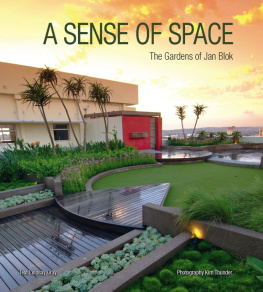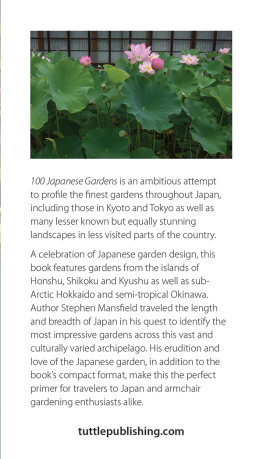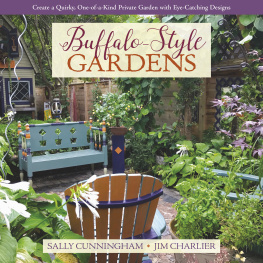
Published in 2009 by Struik Lifestyle
(an imprint of Random House Struik (Pty) Ltd)
Company Reg. No. 1966/003153/07
80 McKenzie Street, Cape Town 8001
PO Box 1144, Cape Town, 8000,
South Africa
Copyright in published edition: Random House Struik (Pty) Ltd 2009
Copyright in text: Jan-Willem Blok and Lindsay Gray 2009
Copyright in photographs: Kim Thunder 2009
Publisher: Linda de Villiers
Editor: Cecilia Barfield
Designer: Helen Henn
Photographer: Kim Thunder
Proofreader: Gavin Barfield
ISBN 978-1-77007-775-1
All rights reserved. No part of this publication may be reproduced, stored in a retrieval system or transmitted, in any form or by any means, electronic, mechanical, photocopying, recording or otherwise, without the prior written permission of the publishers and the copyright holders.
Contents
Introduction
I have always had a passion for design, not only in gardens, but any form of design. I was first introduced to landscaping as a young student when I attended a presentation on the landscaped gardens of the then brand-new Cascades Hotel at Sun City. This was one of the first hotels of its kind with the largest landscaping project undertaken in South Africa. Inspired by what I saw, I knew what career I wanted to follow.
You will find that the gardens showcased in this book have been divided up into spaces. One of my garden philosophies is that if you can see the entire garden from one point, you wont walk in it. Good design isnt a mere fashion statement or a following of current fads; it is timeless.
My gardens are all about geometry and symmetry. The structure of a garden, in relation to the architecture of the home, is important to me. It is not an element that you would necessarily find in nature. Often, when art tries to imitate nature, it falls short because no one can ever truly simulate Gods creation and His attention to detail. All of the gardens in this book have a similar design thread and ethos, whether the focus is more on the traditional or the contemporary, or even a small or large space. The prevailing sense of symmetry and geometry can be clearly seen in the gardens I create; this design trait has come to be known as my signature style.
A highlight for me during the process of this book were the visits to my older gardens, some of which were designed more than ten years ago. I now realise, more than ever, just how much gardening is a discipline in patience. Seeing how essential plants had matured and materials had softened into the landscape was a very rewarding experience. It also emphasises the point that gardens, unlike interior dcor, actually improve with age. To me, plants are merely accessories to the gardens overall layout. By changing other aspects such as ornamentation, construction materials and specific plant species, a traditional garden can become contemporary.
I met Lindsay Gray while I was landscaping Camp Orchards at the beginning of my career. Lindsay approached me to do a series of talks at her garden design school. Our relationship evolved, as did our careers, and, at various stages, the topic of a book arose. It was not until years later, while working on a project in Switzerland, where I had been commissioned by my client to do the garden as well as the interior of the home, that the idea resurfaced. I had asked a close family friend, Kim Thunder, for an image to use in the main entrance area of the interior, which he duly provided. I then came up with a panelled wall design featuring my clients beloved car collection in black and white photography, for his office wall. Kim flew out to take the photos of the car collection, in front of centuries-old churches, in black pine forests and down cobbled streets. The shoot was a success and that evening, while musing over the images, the discussion of doing a book re-emerged. The timing was right, and so A Sense of Space was born.
I would like to thank my whole family, especially my wife, Susan, who is often a sounding-board for many of my designs; Ethan, my son, and Hannah-Rayne, my daughter; Greg Thompson for the extra hours you put into the book; along with my entire team at Blok Designs for interpreting my visions and bringing them to life. I acknowledge the excellent workmanship of my sub-contractors whose work is also demonstrated here. Finally, to all of my clients who have trusted and allowed me to transform their gardens, I thank you.
Jan Blok

I first became acquainted with Jan Blok when the formal, European-style garden he had designed for Camp Orchards in Durban was opened to the public. I was blown away by this mans talent and was also thrilled to have such design expertise on my doorstep. Jan graciously accepted my invitation to address my students on a regular basis regarding the importance of designing gardens on paper. This relationship continued for some years until his busy schedule put paid to his visits. During that time, I mentioned that I would like to write a book about his gardens, to which he consented and so, when Random House Struik approached me to work with them, the project was born.
Jan has a deep understanding of outside space and an innate ability to create a magical and wondrous garden for his clients, which is evidenced by the beautiful photographs taken by equally talented photographer, Kim Thunder.
It has been a delight working on this project, despite the frustrations of unseasonal rain and mist that put paid to many a photo shoot. My sincere thanks go firstly to Random House Struik for giving me this wonderful opportunity to convey in words the talents of Jan Blok; to Jan for entrusting your beautiful gardens to my pen; to Greg Thompson, designer/project manager at Blok Designs, for all the assistance, fun and friendship; to Evan, my English professor, for his honest criticism; and to my beautiful daughter, Erin, for putting many a meal on the table so that I could work uninterrupted.
Lindsay Gray

A Spectacular Ocean View
T he Bluff in KwaZulu-Natal is an imposing headland that forms the south-eastern arm of the Durban harbour. Once covered with uninterrupted natural coastal vegetation, it is now prized residential land for those who hanker after a magnificent view of the Indian Ocean.
This home, with its spectacular one-hundred-and-eighty degree view of the sea, was built in 1949 by Frederick Augustus George Love, a builder by trade. Love travelled from England through Africa with the intention of settling in the Cape, but was so captivated by the Bluffs unspoilt beauty on his arrival in Durban in 1947 that he chose to settle in Durban instead. This is just one of the many houses he built in the area, but its distinguishing feature is that it stretches across two plots of land to enable all the bedrooms to face true east.
The new owners recently renovated the entire home to suit the needs of their young family, after which they turned their attention to the garden. There was no entertainment area to speak of on the sea-facing side, and the narrow, uneven strip of lawn spanning the width of the house fell away steeply to the natural bush below.

Next page















